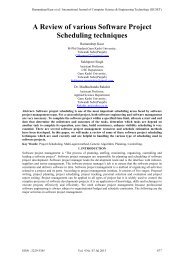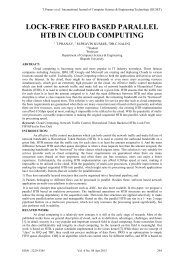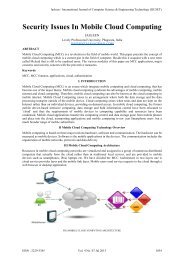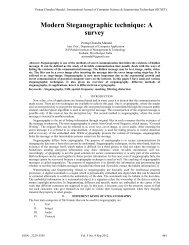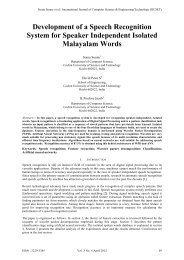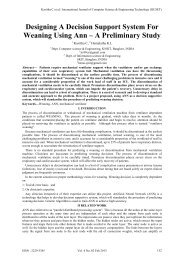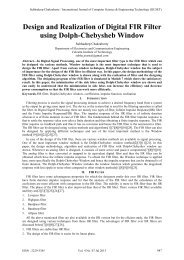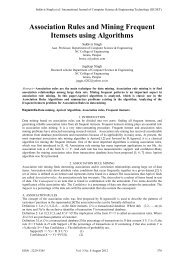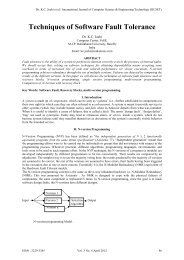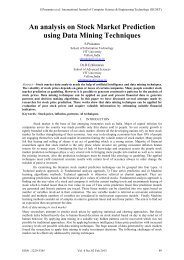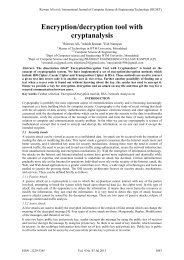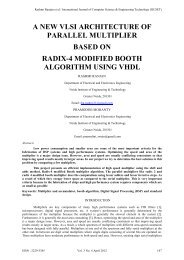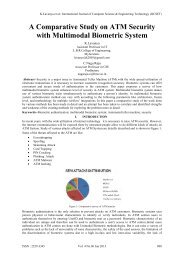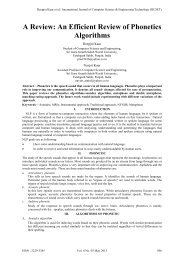S.Tamilselvan et al./ International Journal of Computer Science & Eng<strong>in</strong>eer<strong>in</strong>g Technology (<strong>IJCSET</strong>)• The zero padded frequency-doma<strong>in</strong> block { , k= 0,1,…N’-1}, where N’ is a powerof two, is <strong>for</strong>med byadd<strong>in</strong>g N-N’ zeros to the orig<strong>in</strong>al frequency-doma<strong>in</strong> blockis given Eqn.(1).As other multicarrier signals, MC-CDMA signals have high envelope fluctuations and a high peak-to-meanenvelopee power ratio (PMEPR), which leads to amplification difficulties. This is particularly important <strong>for</strong> theupl<strong>in</strong>k transmission, s<strong>in</strong>ce efficientlow-cost power amplification is desirable at the mobile term<strong>in</strong>als (MTs).Moreover, the transmission over time-dispersivechannels destroys the orthogonality between spread<strong>in</strong>g codes,which might lead to significant multiple-access <strong>in</strong>terference levels and frequent runn<strong>in</strong>g of HPA <strong>in</strong>to saturationregion reduces the power efficiency. To reduce the envelope fluctuations of the transmitted signals, whilema<strong>in</strong>ta<strong>in</strong><strong>in</strong>g the spectral efficiency, the MC-CDMA signal associated to each MT is submitted to a clipp<strong>in</strong>gdevice, followed by a frequency doma<strong>in</strong> filter<strong>in</strong>g operation. However, the<strong>non</strong><strong>l<strong>in</strong>ear</strong> distortion effects can behigh when an MC-CDMA transmitter with reduced envelope fluctuations is <strong>in</strong>tended.II. CHOICE OF PMEPR REDUCTION TECHNIQUEThere have been many proposal of methods <strong>in</strong>which the power ratio can be reducedd <strong>in</strong> MC-CDMA multi-ofcarrier signals. Some researchers have developedd methods of achiev<strong>in</strong>g lowPMEPR through the application“partial transmits sequence, block cod<strong>in</strong>g and selected mapp<strong>in</strong>g”. Other techniques oflower<strong>in</strong>g thePMEPRratio which have been published <strong>in</strong>volve complicated applications of supplementaryFFT function blocksrequir<strong>in</strong>gmore functional components. In addition, <strong>non</strong>-hardware basedapproaches that also <strong>in</strong>cur otherdisadvantages such as add<strong>in</strong>g <strong>in</strong><strong>for</strong>mation <strong>in</strong> overhead parameters or handshak<strong>in</strong>g algorithms to control PMEPRlevels. Additional <strong>in</strong><strong>for</strong>mation bear<strong>in</strong>g causes OFDM signal to be less bandwidth efficient.Though a class of low-complexity signal-process<strong>in</strong>g <strong>scheme</strong>s <strong>for</strong> reduced PMEPR, spectrally efficient MC-aCDMA transmission proposed requires supplementary FFTfunction blocks, but this <strong>scheme</strong> comb<strong>in</strong>es<strong>non</strong><strong>l<strong>in</strong>ear</strong>operation <strong>in</strong>the time doma<strong>in</strong> with a <strong>l<strong>in</strong>ear</strong>, filter<strong>in</strong>g operation <strong>in</strong> the frequency doma<strong>in</strong>. Thisfrequency-doma<strong>in</strong> filter<strong>in</strong>g, besidess not requir<strong>in</strong>g an <strong>in</strong>creased guard time to avoid <strong>in</strong>tersymbol <strong>in</strong>terference(ISI), canbe very selective, e.g., completely remov<strong>in</strong>g theout-of-band radiation effects of the preced<strong>in</strong>g<strong>non</strong><strong>l<strong>in</strong>ear</strong>operation.More recently, a similar class of signal-process<strong>in</strong>g <strong>scheme</strong>ss <strong>for</strong> the samegoals was analyzed. The differencelies <strong>in</strong> the type of <strong>non</strong><strong>l<strong>in</strong>ear</strong> operation with each class: a <strong>non</strong><strong>l<strong>in</strong>ear</strong>ity operat<strong>in</strong>g on thecomplex MC-CDMAsamples <strong>in</strong> [8], and a <strong>non</strong><strong>l<strong>in</strong>ear</strong>ity which separately operates ontheir real (I)and imag<strong>in</strong>ary (Q) parts <strong>in</strong>[9]. Our<strong>scheme</strong> considers the <strong>for</strong>mer class only, which provides better per<strong>for</strong>mance,and studies the cases where a given<strong>scheme</strong> (<strong>non</strong><strong>l<strong>in</strong>ear</strong> time-doma<strong>in</strong> operation followed by frequency-doma<strong>in</strong>filter<strong>in</strong>g) is repeatedly used, <strong>in</strong> aniterative way.Though the proposed method that is focused on does not require additional FFT’s operators and only requires<strong>in</strong>gle FFT and IFFT functions <strong>in</strong> the transceiverss to operate. The technique <strong>in</strong>volves the shap<strong>in</strong>g of time limitedsubcarrier pulses. Themodificationof subcarrier pulse shapes does not add extra <strong>in</strong><strong>for</strong>mation to the exist<strong>in</strong>gstructure of MC-CDMA signals and hence bandwidth efficiency is unaffected. Cod<strong>in</strong>gmethods as describedpreviously can assist <strong>in</strong>controll<strong>in</strong>g <strong>in</strong>terchannel <strong>in</strong>terference through channel cod<strong>in</strong>g.There<strong>for</strong>e, through the use of this<strong>non</strong>-<strong>l<strong>in</strong>ear</strong> signal process<strong>in</strong>g <strong>scheme</strong>, certa<strong>in</strong> pulse shape characteristics canbe tested<strong>in</strong> search <strong>for</strong> the best pulse characteristics. Theobjective is to f<strong>in</strong>d thegeneral pulse shapecharacteristics that promote the improvements <strong>in</strong> lower<strong>in</strong>g the factor of high PMEPRfound <strong>in</strong> MC-CDMAsignals.III. TRANSMISSION OF MC-CDMA SIGNALA WIDE CLASS OF NONLINEAR SIGNAL-PROCESSING SCHEMEWith the basic signal-process<strong>in</strong>g<strong>scheme</strong>s considered here <strong>for</strong> MC-CDMAtransmission is shown <strong>in</strong>Figure 1,each block of time-doma<strong>in</strong> samples is generated as follows.Figure 1 BlockDiagram <strong>for</strong> Proposed TechniqueeISSN : 2229-3345 Vol. 3 No. 3 March 2012 15
S.Tamilselvan et al./ International Journal of Computer Science & Eng<strong>in</strong>eer<strong>in</strong>g Technology (<strong>IJCSET</strong>) ; , ,… (1)• The Inverse Discrete Fourier Trans<strong>for</strong>m (IDFT) of this frequency-doma<strong>in</strong> block is computed, lead<strong>in</strong>g to thetime doma<strong>in</strong> block { ; n=0,1,...N-1} with is given Eqn.(2). ∑ (2) • Each sample is submitted to a <strong>non</strong><strong>l<strong>in</strong>ear</strong> operation(an envelope clipp<strong>in</strong>g)accord<strong>in</strong>g to, lead<strong>in</strong>g to themodified block { ; n=0,1,…,N’-1}, where is given Eqn.(3). | | (3)• A discrete Fourier trans<strong>for</strong>m (DFT) br<strong>in</strong>gs the <strong>non</strong><strong>l<strong>in</strong>ear</strong>ly modified block back to the frequency doma<strong>in</strong>,where a shap<strong>in</strong>g operation is per<strong>for</strong>med by a multiplier bank with selected coefficients, {Gk; k=0,1,…,N’-1}, so as to obta<strong>in</strong> the block , with is given by the Eqn.(4). ;,,…. (4)• The f<strong>in</strong>al frequency-doma<strong>in</strong> block results from by remov<strong>in</strong>g the zeros, where is shown <strong>in</strong>Eqn.(5). ;,,…….. (5)• Append<strong>in</strong>g zeros to each <strong>in</strong>put block prior to comput<strong>in</strong>g the required IDFT is a well-known OFDMimplementation technique, which is equivalent to oversampl<strong>in</strong>g, by a factor given <strong>in</strong> Eqn.(6) below, theideal MC-CDMA burst. (6)• The subsequent <strong>non</strong><strong>l<strong>in</strong>ear</strong> operation is crucial <strong>for</strong> reduc<strong>in</strong>g the envelope fluctuations, whereas the frequencydoma<strong>in</strong>filter<strong>in</strong>g us<strong>in</strong>g the set given <strong>in</strong> Eqn.(7) can reduce the result<strong>in</strong>g spectral spread<strong>in</strong>g (of course, withsome regrowth of the envelope fluctuations). ;,,,……, (7)The removal of subcarriers with zero amplitude reduces the computational ef<strong>for</strong>t and corresponds todecimation <strong>in</strong> the time doma<strong>in</strong>. For a given and a careful selection of , the <strong>non</strong><strong>l<strong>in</strong>ear</strong> characteristic (<strong>for</strong> a given<strong>in</strong>put level) and the set can {Gk} ensure small envelope fluctuations while ma<strong>in</strong>ta<strong>in</strong><strong>in</strong>g low out-of-bandradiation and <strong>in</strong>-band self-<strong>in</strong>terference levels. When the <strong>non</strong><strong>l<strong>in</strong>ear</strong> operation is chosen to be an ideal envelopeclipp<strong>in</strong>g, with clipp<strong>in</strong>g. , , (8)It should be mentioned that this wide class of signal-process<strong>in</strong>g <strong>scheme</strong>s <strong>in</strong>cludes, as specific cases, <strong>scheme</strong>sproposed so far. where the same clipp<strong>in</strong>g is adopted when assum<strong>in</strong>g ,the condition <strong>in</strong> Eqn.(8) with <strong>for</strong> the <strong>in</strong>bandsubcarriers, and out-of-band. It should also be mentioned that, <strong>for</strong> an ideal envelope clipp<strong>in</strong>g, the proposedsignal-process<strong>in</strong>g <strong>scheme</strong> can be shown to be equivalent to the peak cancellation method.A more sophisticated technique, allow<strong>in</strong>g improved PMEPR reduc<strong>in</strong>g results, could be simply developed onthe basis of the signal-process<strong>in</strong>g approach described above. Such a technique consists of repeatedly us<strong>in</strong>g, <strong>in</strong> aniterative way, the signal-process<strong>in</strong>g cha<strong>in</strong> which leads from to <strong>in</strong> Fig.1. The technique proposed <strong>in</strong> [17]corresponds to the particular case where the <strong>non</strong><strong>l<strong>in</strong>ear</strong> operation is an envelope clipp<strong>in</strong>g, and the frequencydoma<strong>in</strong>filter<strong>in</strong>g is characterized by <strong>for</strong> the Gk=0 <strong>for</strong> the out-of-band subcarriers.ISSN : 2229-3345 Vol. 3 No. 3 March 2012 16



